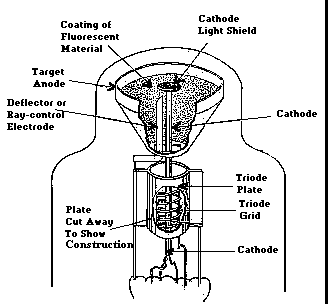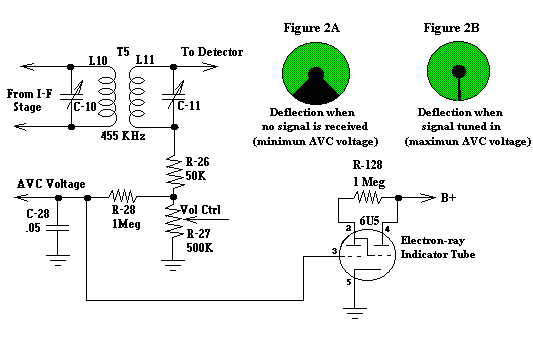 |
 |
The target anode has a coating of fluorescent material that glows when struck by electrons. The target anode is connected to B+ of the receiver and attracts electrons from the cathode. The deflector electrode is a thin vertical vane between the cathode and the target and is connected to the plate of the triode section. This vane shades a small portion of the target and prevents some of the electrons from striking that part of the target leaving a nonflourescent or shadow area. The width of the shadow depends upon the relative voltages between the deflector and the target. The more negative the voltage on the deflector with respect to the target, the more electrons are deflected from the area of the target that is behind the deflector and the larger the shadow. A strong negative voltage on the deflector will produce a large shadow (see Figure 2A below). When the deflector is at the same voltage potential as the target, few electrons are deflected and the shadow is small (see Figure 2B below). For intermediate values of voltages on the deflector, the angle of the shadow is somewhere in between the two extremes. The dark spot in the center is caused by the cathode light shield.
 |
Refer to the schematic in Figure 2 above.
The target anode (pin 4) is connected to the B+ of the receiver, and the plate
of the triode (pin 2) is connected to B+ through R-128, a 1 megohm
resistor. Notice that the deflector is tied internally to the plate of the
triode so it will always be at the same voltage potential as the plate.
The grid (pin 3) of the triode section is connected to the AVC voltage bus of the
receiver. The amount of AVC voltage developed is dependent upon the strength
of the signal being received. When no signal is being received, the AVC
voltage is zero. This permits a relatively high flow of plate current in the
triode which causes a high voltage drop across R-128. This results in
a much less positive voltage on the plate of the triode and the deflector
anode. Since the target anode is connected directly to the B+ supply, it is
much more positive than the deflector therefore electrons are deflected at a
wide angle, causing a wide shadow on the target. When the receiver is tuned
to a station, the AVC voltage developed causes the grid to become more
negative which causes the plate current to decrease, reducing the voltage
drop across R-128.
This makes the triode plate and the deflector more positive with respect
to the target anode, thus the deflection of electrons is less and the shadow
angle narrows. A strong signal can produce enough AVC voltage to completely
cut off the current flow in the triode so that there would be no voltage
drop across R-128, and the plate and deflector would be at the same
voltage potential as the target. This would produce very little or no shadow
on the target.
The CHRS Website has a tips page on tuning eye tubes.
| Type | Typical Plate and Target Voltage | Series
Triode Plate Resistor | Triode-Grid Voltage |
|---|---|---|---|
| 6E5 | 250 | 1 megohm | -8.0 for shadow angle of 0 degrees 0 for shadow angle of 90 degrees |
| 6G5/6H5 | 250 | 1 megohm | -22 for shadow angle of 0 degrees 0 for shadow angle of 90 degrees |
| 6U5 | 250 | 1 megohm | -22 for shadow angle of 0 degrees 0 for shadow angle of 90 degrees |
| 1629 | 250 | 1 megohm | -8.0 for shadow angle of 0 degrees 0 for shadow angle of 90 degrees |
   |